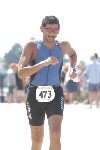(My solo 6 mile swim)
While searching for some open water swims around the west coast (so we could just drive rather than fly) I came across the La Jolla Cove 10 mile relay in San Diego (SD). They had an option to swim 10 miles solo as well. So I emailed the organizers and asked them to let me know when the registration opens up. Given that I was already slated for a 5 mile swim around Angel Island - I figured I could swim about 6-7 miles and we could use the trip to SD to meet some friends who had moved there. Basically a fun swim in a new place.
The drive was an uneventful 8.5 hours! The Hybrid car meant we could drive straight through with no need for a gas stop! 468 miles on a tank of gas and still some left! After a wonderful couple of days with friends I was all set for a long swim on Sunday Sep 26th.
Event day: September 26th
Where: La Jolla Shores Beach
Weather: Sunday was an overcast but calm day.
Water temp: 61F-63F
Fuel: Gu gel & Gatorade, about 150/180 calories/hr.
Gear: Sleeveless wetsuit.
It turned out to be a huge event - there were 133 relay teams (up to 5 swimmers per team) and 20 solo swimmers, a total of 652 swimmers! The event section of the beach was crowded with teams, supporters, and volunteers. The rest of the beach was also getting crowded with weekend beachgoers. At 6:30AM the parking lot was almost full! We managed to get one of the last few spots and I rushed to get into the bathroom line. All swimmers had to have a beach volunteer, so Renuka was to take care of my swim feeds and make sure all my loops were counted. We tried to get one of the many groups to let her share their picnic tent, but luckily since it was an overcast and cool day, she did not need the shade. We set up our chair and icebox and I started suiting up.
 |
| The swim loops (Coros watch) |
The swim was set up as one mile triangle loops with all swimmers having to exit the water and run up the beach through a timing chute and back in for the next loop. As this was primarily a relay event, it made sense to have everyone (including the solo swimmers) follow the same protocol. This was similar to the 10K swim I had done in LA almost a decade ago (OptimisSport - Distance Swim Challenge) - although that entailed swimming along the coast and exiting at different beaches. The good thing here was it was looping back to the same beach - logistically much easier for the support crew.
I did not hear the swim start - but apparently it started at 7:00AM sharp! I was a bit confused as one of the buoys was still being towed into place - one of the organizers said to me 'unless you swim faster than that water scooter towing the buoy, you should be good to start - the buoy will be in place before you get there - GO!' I chuckled and ran in. Tandy showed up to cheer me on and I was glad to see her - that also meant that Renuka would not be alone for the duration of the swim.
 |
| Wait! Did they start!? |
For the first loop I was pretty much alone as I started about 3 mins after everyone. I felt pretty good, the water was a bit warmer than in Northern California and the ocean was calm. Loop 2 (mile 2) I took in some Gatorade and proceeded to mile 3. For a brief moment the sun broke through and the clarity of the water was brilliant - I could see some big fish idling around and the water was still nice and calm.
Other than a few upwellings of some really cold water, the water temp was good 62F-63F. By mile 5 my wetsuit started cutting into my back and that was a bit painful (once the skin splits, the wetsuit friction and salt water makes it a continuously irritating burn). After the first loop there were plenty of swimmers around. It was nice to see the different styles, stroke rates as they powered by. Since it is a fun event, swimmers were allowed to wear flippers, snorkels, whatever one wanted. There were a bunch of SCUBA divers as well, we could see their bubbles rising up every now and then. At one point there was this huge pod or murmuration of birds that came through - all in a line just a few feet about the water - quite a spectacular sight!
 |
| Looping through the timing chute. |
Unlike the swims in San Francisco Bay, there is no tide/current assist here. You actually swim the distance. Mile 6 was tough, I could feel my arms. Given that we were to drive back right after the swim I decided to stop at 6 and not go for the 7th mile. I let the organizers know and after a quick shower at the beach - we headed back home for another 8.5 hours in the car. All in all a wonderful trip and a great event, well organized and super friendly volunteers. I'll be back next year to do the full 10 miles :) maybe we will have a few relay teams in as well.
I finished the 6 miles in 4:07:29 (the official time) - check out the last name on the list :)













